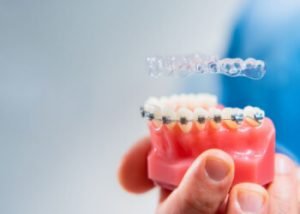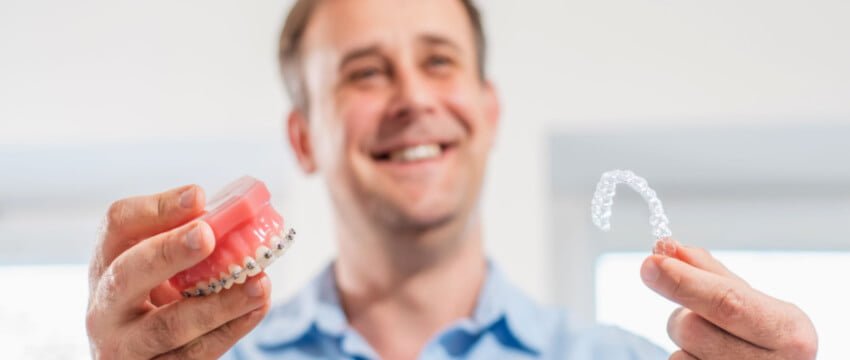With modern and effective dental and orthodontic practices, crooked teeth, jaws, and poor bite patterns don’t have to remain a problem. But deciding which treatment option is the best for you can be daunting.
Two popular treatment options often recommended by dentists are traditional braces and Invisalign clear dental aligners. When deciding between Invisalign vs braces, it is essential to understand some basic information about each option.
Invisalign vs Braces: Why You Need an Orthodontic Device
If not corrected with dental appliances, crooked or overlapping teeth can cause serious problems such as:
- A higher risk of tooth decay and gum disease when overlapping or crowded teeth prevent proper oral care.
- A misaligned bite can lead to difficulty chewing or speaking.
- Severe physical discomfort or emotional trauma.
Invisalign vs Braces: Traditional Braces
Traditional braces are used for complex orthodontic issues and for specific misalignment issues that Invisalign can’t address. Teeth rotated more than 20°, super-extended teeth, microdontia, and extreme overjet cannot be treated with clear aligners. Braces offer the structural elements and intense pressure required to correct these issues. Other pros and cons of traditional braces include:
Pros of Traditional Braces
Traditional braces are suitable for treating various orthodontic issues in patients of all ages. They are primarily offered to teens and young adults because their jawbones are still developing, allowing the teeth to shift quickly and easily.
Despite being highly noticeable, modern braces come in various colours, from tooth-coloured ceramic brackets and wires to bold jewel-toned hardware, allowing patients to customise their appearance.
Traditional braces provide constant care. Unlike Invisalign, braces cannot be removed, ensuring that they apply continuous pressure to keep you on your treatment schedule.
Cons of Traditional Braces
Traditional braces are easily recognizable because of their metal components, making some patients feel self-conscious and reluctant to smile or engage in social situations.
The metal parts can also be uncomfortable to wear, especially if you need to wear headgear in addition to the bracket system. The metal parts can break and cut your mouth’s soft tissues.
You need to attend orthodontic visits approximately every four weeks to have your braces tightened and adjusted, resulting in higher overall costs and increased discomfort.
You must also modify your diet and oral hygiene routine when wearing braces. Hard, crunchy, and sticky foods can become stuck in the brackets or damage the archwires. You’ll need to brush carefully and use a floss threader with unwaxed floss to help it access around the brackets. You can also use fine interdental brushes.
Invisalign vs Braces: Invisalign
Over the past couple of decades, Invisalign has grown in popularity as an orthodontic treatment option. Introduced to the consumer market in 1998 by Align Technology, Invisalign clear aligners are a modern and innovative take on teeth straightening.
Invisalign straighteners are clear plastic aligners made from a flexible thermoplastic material called SmartTrack. Invisalign is a series of clear aligners that slowly reposition your teeth according to the treatment plan created by your dentist.
Pros of Invisalign
Invisalign clear aligners have been gaining popularity over traditional braces for a few years. While they may be unable to fix severe bite issues, clear aligners offer some advantages, especially when discussing Invisalign vs braces.
Invisalign clear aligners are removable. Although they should remain in your mouth for the time your dentist prescribes, you can remove them for a special event. You can also remove them to eat and brush your teeth, so you don’t have to change your diet or oral hygiene routine.
Cosmetic factors are a significant consideration when deciding whether braces vs Invisalign is best for you. Many people prefer clear aligners over traditional braces because they are virtually invisible, making you less self-conscious about orthodontic treatment.
Cons of Invisalign
 Invisalign is an effective treatment for some patients, but those with bridgework, or patients who need more complex orthodontics, may not be a good candidate.
Invisalign is an effective treatment for some patients, but those with bridgework, or patients who need more complex orthodontics, may not be a good candidate.
Invisalign requires you to follow your dentist’s instructions. Typically, they must be worn for between 20 and 22 hours each day and should only be removed for eating and drinking. If left in while eating or drinking, food and liquids can seep into the aligners, allowing bacterial growth, tooth decay, gum disease, and staining of your teeth and aligners.
Some sensitivity can also occur because of the movement created. Your dentist may recommend avoiding very hard or difficult-to-chew foods.
Invisalign vs Braces Which is Better?
When considering orthodontic treatments, you may wonder about Invisalign vs. braces: which is better? The answer depends on the nature of your misalignment and dental malocclusions.
To find the right treatment for you, visit an experienced dentist from Lakeside Dental Studio. Our dentist will perform a manual examination of your teeth and jaws and then take X-rays and digital scans of your mouth to assess the location and position of your teeth.
Using this information, they can create a personalised treatment plan for you that maps out how your teeth will move throughout the treatment and when you need to visit your dentist for adjustments or a checkup.
Achieve a Winning Smile With Lakeside Dental Studio
Malocclusions not only impact the appearance of your smile but can have a severe adverse effect on your oral health, increasing your risk for tooth decay, gum disease, and enamel erosion. If you have crooked teeth or a misaligned bite, visit Lakeside Dental Studio for a consultation to determine if you need braces vs Invisalign to correct your smile. Contact Lakeside Dental Studio at (02) 4971 3366 to make an appointment.
Note: Any surgical or invasive procedure carries risks. Before proceeding, you should seek a second opinion from an appropriately qualified health practitioner.
References
Teeth straightening and braces
https://www.teeth.org.au/teeth-straightening-and-braces
Orthodontic treatments
https://www.healthdirect.gov.au/orthodontic-treatments
Dental braces and retainers
https://www.healthdirect.gov.au/dental-braces-and-retainers
What Are the Treatment Options for Overlapping Teeth?
https://www.healthline.com/health/overlapping-teeth
What to Know About Invisalign and Its Effectiveness
https://www.healthline.com/health/does-invisalign-work
How Much Does Invisalign Cost and How Can I Pay for It?
https://www.healthline.com/health/invisalign-cost


Recent Comments